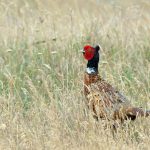Judges explain how to better prepare to pass your next retriever event
By Larry Saavedra
Photography by Quick Dog Productions
As retriever hunt test competitors, we have a lot more in common than our love of dogs and the great outdoors. There are common mistakes seen at all levels of the hunt test game, too, according to test judges from across the U.S. and Canada. In speaking with qualified judges from the major sanctioning bodies, I learned that these common mistakes fall into the categories of rules, obedience, lining, and foundational skills.
So what is it that judges are looking at when we come to the line and run a test? I asked several judges for their thoughts, tips, and what sorts of things influence their decisions.

Tip #1: Rules Define a Test
Each sanctioning body has a different set of rules that they use when evaluating a handler and dog. The rules clearly define the hunt test parameters and setup in detail. Rules spell out what’s expected from you and your dog in each series, and address even the style of clothing you should wear, down to your boots.
Following the rules can go a long way in making yourself look like a pro. Not understanding them before you run your dog could have the exact opposite effect on whether you pass or fail a test. Something that judge Ronnie Harwell of the Hunting Retriever Club knows a lot about. Harwell of Mississippi has judged HRC events for 23-plus years, and he is a vocal proponent of handlers wearing camouflage gear.
“You can’t come into my HRC pit and hunt with blue jeans and a tan t-shirt,” Harwell said. People need to come to tests with gun-ready dogs, wearing hunt-ready gear of choice, which is camouflage. I’ll let people borrow my personal camouflage clothes if necessary. But it’s required in our upper stakes like the Grand level. If you want to wear whatever, then the AKC field trials game is the place to run your dog.
“In truth, that dog could care less if you’re standing on the line in your Fruit of the Looms. But as a handler, you wouldn’t you want your two judges sitting behind you wearing white baseball caps and white shirts and moving around as you’re trying to handle your dog.
Certain colored clothing distracts the dog. HRC judges are held to a higher standard and are required to be in camouflage, or hunting environment gear from our hats to our pants. Camouflage should not be a nuisance to handlers.”

Fellow Mississippian, Glenn Dye, of the HRC wholeheartedly agreed with Harwell about reading and following the rules. “Handlers sometimes don’t read the rule books even though it’s free,” he said. Dye has judged from coast-to-coast and has seen the same issues happening elsewhere in HRC. He said, the club offers a regular seminar for handlers that educates them about the rules. “It would benefit every handler running an HRC event to attend one of our seminars to listen to how judges are being taught to evaluate the entries. Handlers would learn how and why HRC judges score the way they do.”
Echoing these observations, AKC judge Diane Crider from Arizona said, “It bests serves handlers to review the rules first.”
To illustrate the point, Crider cited an incident that happened not long ago at an event. “At an AKC Senior test, the judges had a diversion bird on the way back from second bird fall [mark], and a handler’s dog switched birds to pick up the diversion bird instead of carrying the original bird to the handler,” she said. “The handler had not trained for this scenario and told the judges that a diversion bird was for Master level advanced dogs. He was very upset, even though in the rules [page 32, section 7] it states, Senior test judges can use a diversion bird in the setup. The handler simply misread the rules.”
AKC judge Kevin Buckley of Pennsylvania has had similar experiences. “People often have no knowledge of the rules, and assume that bringing the birds back means that they have passed the test,” he said.“In Junior level hunt tests, my experience is that many first timers have never opened a rule book. They have been encouraged by friends that they should run their dog but have no idea there are actual rules. I always bring extra rule books to Junior events and give them out before I start my scenario of the test.”
So as Buckley and the others concluded, handlers might fail simply because they don’t open a rule book, which are provided free online from every sanctioning body. Even a cursory review of the rules before a test will go a long way in building your confidence on the line.
Tip #2: Obedience Skills

Another common mistake judges see is a lack of basic obedience in dogs. An obedient dog going to the line is going to be steadier than an out-of-control dog, and that should be your goal. Obedient dogs heel with the handler, and they sit on command to mark birds considerably better than those pulling you or creeping at the line.
Here’s a tip: Before you step into a holding blind, consider changing the way you enter and exit it. Professional trainer Mitch White of Gamekeeper Retrievers in Ohio said, “When dogs get too excited facing head first in a holding blind and want to climb over or around it to look at the field, re-heel them and face the dog in the other direction away from the action. It puts you back in control.”
Line manners matter. AKC judge Don Freeman of Colorado said that poor obedience coming to the line is a common problem. “Knowing how to walk to the line properly is the biggest culprit for new handlers,” he said. “Restraint coming to the line is an issue mostly in Junior handlers. I didn’t say too much restraint because how much is too much varies judge-to-judge. I am tolerant of more restraint than many judges because I really hate to see a sub two-year-old dog yawning as the bird goes down.
“But in AKC Senior, obedience issues are a result of a lack of communication [between handler and dog] at the line. Breaking [leaving the line prematurely] is certainly a common indicator here. But more common than breaking is poor lining techniques. We see poor initial lines even on go-birds, but especially on memory birds; sending before the dog says, I got it! probably fails more dogs than anything else.”
AKC judge Robert Bush of Pennsylvania thought obedience was the biggest single issue he sees, too. “A lot of handlers skip over obedience and go right to retrieving,” Bush said. “That always comes back to bite them.”
Tip #3: Lining Mistakes
The ability of a retriever to take a straight line to a fall or blind is paramount to winning over the judges. It all starts with simply planting your feet in the direction of the fall. Still, judges are seeing problems.
AKC judge Bonnie McGhie from British Columbia views lining problems as the major reason why people fail a hunt test.McGhie has judged retriever hunt tests since the late ’90s. She’s holds the distinction of being the first Canadian Kennel Club judge qualified as an AKC Master judge.“Plan ahead to decide how to leave the holding blind, and where to face the dog on the line,” she said. “Circle or re-heel the dog around if it’s necessary to reposition, rather than crowding, or trying to knee a dog into position. Checking for any interference on the way to line, like the honor dog, chairs, buckets or racks of birds will help. Avoid trying to over-control the dog as a way to deal with your own nervousness, or uncertainty. Using repeated commands such as sit, sit, sit when the dog comes to the line makes judges wonder about the dog’s training.”
AKC judge Ed Arnett of Colorado said lining is an issue that needs to be addressed before a hunt test. “Handlers are too quick to release their dogs and aren’t paying attention to where they are looking,” said Arnett. “As a judge, you are usually behind the handler and dog, and can easily see that the dog is not looking at the mark and gets sent anyway. On multiple marks, I often see handlers go way too fast by sending their dogs too quickly. Handlers need to work as a team with their dog and help them in every way possible. They need to slow down, but not too slow, and make sure their dog is looking right where that mark is, and line that dog’s spine with the line to the blind and make sure they are looking that way when they send them.”

Again, the consensus of judges tells us that embracing the basics or fundamentals of training retrievers will help ensure success at passing hunt tests. Lining is an advanced concept but can be learned with attrition training drills. A dog that takes a good line to a fall will make a handler’s job much easier.
Tip #4: Building on the Basics
Our final words of wisdom from judges deal with “foundation,” or what some see as the natural ability of the dog on which other skills can be developed. Dogs without a solid foundation like marking and perseverance often exhibit undesirable behaviors that put handlers at risk of being dropped in a series.
Elaborating on that theory, AKC judge Willie Alderson of Idaho believes handlers are far too reactive when they need to be proactive in hunt tests. “This falls back to handlers lack of experience [in competition],” said Alderson. I see dogs without a solid foundation of the basics like line manners, delivery issues, and whistle response. Sometimes judges pass them and then bigger problems develop as they move up to Senior and Master level tests.”
Fellow Idaho resident and AKC judge David Coffey views basic foundation work critical to success. “The problems that I see most often in the Junior and Senior stakes is directly related to the handler’s attitude on life; they are looking for instant gratification,” Coffey said. “They do not take the time to establish fundamental skills before entering hunt tests. Begging a dog to ‘fetch it up’ ad nauseam could be simply solved by taking the pup through force-fetch, or better yet, putting the tests on hold for a few months and taking the pup through basics and transition. These handlers and dogs are often passed through the Junior level because judges feel they are doing the handler and sport a service by turning a blind eye for fear of losing ‘new blood’ in the sport.”
As Coffey and others pointed out, if these same young dogs and handlers reach the advanced levels, they often exhibit poor line manners. Controlled breaks seem to be commonplace with both the working and honoring dogs. These are all fixable issues when you take time to establish a solid foundation.
Making mistakes is simply part of the process of becoming a well-rounded handler, but the judges are there to help us. Learn the rules, practice obedience, sharpen your lining skills, and always build on your dog’s foundation. Together, it will go a long way in gaining the confidence seen in advanced handlers.
Surely, judges are not infallible, they make mistakes like the rest of us. But without judges, the hunt test would not exist, and heeding their advice is a powerful tool.
Larry Saavedra has been an AKC Hunt Test judge since 2005. He can be reached at Larry@quickdogproductions, or by visiting his website www.QuickDogProductions.com.
This article was originally featured in the April/May 2019 issue of The Retriever Journal and has been posted online with the author’s permission.





